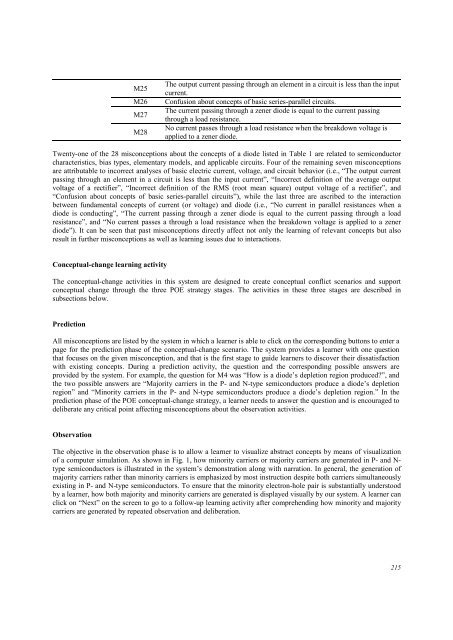Correcting Misconceptions on Electronics: Effects of a simulation ...
Correcting Misconceptions on Electronics: Effects of a simulation ...
Correcting Misconceptions on Electronics: Effects of a simulation ...
Create successful ePaper yourself
Turn your PDF publications into a flip-book with our unique Google optimized e-Paper software.
M25<br />
The output current passing through an element in a circuit is less than the input<br />
current.<br />
M26 C<strong>on</strong>fusi<strong>on</strong> about c<strong>on</strong>cepts <strong>of</strong> basic series-parallel circuits.<br />
M27<br />
The current passing through a zener diode is equal to the current passing<br />
M28<br />
through a load resistance.<br />
No current passes through a load resistance when the breakdown voltage is<br />
applied to a zener diode.<br />
Twenty-<strong>on</strong>e <strong>of</strong> the 28 misc<strong>on</strong>cepti<strong>on</strong>s about the c<strong>on</strong>cepts <strong>of</strong> a diode listed in Table 1 are related to semic<strong>on</strong>ductor<br />
characteristics, bias types, elementary models, and applicable circuits. Four <strong>of</strong> the remaining seven misc<strong>on</strong>cepti<strong>on</strong>s<br />
are attributable to incorrect analyses <strong>of</strong> basic electric current, voltage, and circuit behavior (i.e., “The output current<br />
passing through an element in a circuit is less than the input current”, “Incorrect definiti<strong>on</strong> <strong>of</strong> the average output<br />
voltage <strong>of</strong> a rectifier”, “Incorrect definiti<strong>on</strong> <strong>of</strong> the RMS (root mean square) output voltage <strong>of</strong> a rectifier”, and<br />
“C<strong>on</strong>fusi<strong>on</strong> about c<strong>on</strong>cepts <strong>of</strong> basic series-parallel circuits”), while the last three are ascribed to the interacti<strong>on</strong><br />
between fundamental c<strong>on</strong>cepts <strong>of</strong> current (or voltage) and diode (i.e., “No current in parallel resistances when a<br />
diode is c<strong>on</strong>ducting”, “The current passing through a zener diode is equal to the current passing through a load<br />
resistance”, and “No current passes a through a load resistance when the breakdown voltage is applied to a zener<br />
diode”). It can be seen that past misc<strong>on</strong>cepti<strong>on</strong>s directly affect not <strong>on</strong>ly the learning <strong>of</strong> relevant c<strong>on</strong>cepts but also<br />
result in further misc<strong>on</strong>cepti<strong>on</strong>s as well as learning issues due to interacti<strong>on</strong>s.<br />
C<strong>on</strong>ceptual-change learning activity<br />
The c<strong>on</strong>ceptual-change activities in this system are designed to create c<strong>on</strong>ceptual c<strong>on</strong>flict scenarios and support<br />
c<strong>on</strong>ceptual change through the three POE strategy stages. The activities in these three stages are described in<br />
subsecti<strong>on</strong>s below.<br />
Predicti<strong>on</strong><br />
All misc<strong>on</strong>cepti<strong>on</strong>s are listed by the system in which a learner is able to click <strong>on</strong> the corresp<strong>on</strong>ding butt<strong>on</strong>s to enter a<br />
page for the predicti<strong>on</strong> phase <strong>of</strong> the c<strong>on</strong>ceptual-change scenario. The system provides a learner with <strong>on</strong>e questi<strong>on</strong><br />
that focuses <strong>on</strong> the given misc<strong>on</strong>cepti<strong>on</strong>, and that is the first stage to guide learners to discover their dissatisfacti<strong>on</strong><br />
with existing c<strong>on</strong>cepts. During a predicti<strong>on</strong> activity, the questi<strong>on</strong> and the corresp<strong>on</strong>ding possible answers are<br />
provided by the system. For example, the questi<strong>on</strong> for M4 was “How is a diode’s depleti<strong>on</strong> regi<strong>on</strong> produced?”, and<br />
the two possible answers are “Majority carriers in the P- and N-type semic<strong>on</strong>ductors produce a diode’s depleti<strong>on</strong><br />
regi<strong>on</strong>” and “Minority carriers in the P- and N-type semic<strong>on</strong>ductors produce a diode’s depleti<strong>on</strong> regi<strong>on</strong>.” In the<br />
predicti<strong>on</strong> phase <strong>of</strong> the POE c<strong>on</strong>ceptual-change strategy, a learner needs to answer the questi<strong>on</strong> and is encouraged to<br />
deliberate any critical point affecting misc<strong>on</strong>cepti<strong>on</strong>s about the observati<strong>on</strong> activities.<br />
Observati<strong>on</strong><br />
The objective in the observati<strong>on</strong> phase is to allow a learner to visualize abstract c<strong>on</strong>cepts by means <strong>of</strong> visualizati<strong>on</strong><br />
<strong>of</strong> a computer simulati<strong>on</strong>. As shown in Fig. 1, how minority carriers or majority carriers are generated in P- and Ntype<br />
semic<strong>on</strong>ductors is illustrated in the system’s dem<strong>on</strong>strati<strong>on</strong> al<strong>on</strong>g with narrati<strong>on</strong>. In general, the generati<strong>on</strong> <strong>of</strong><br />
majority carriers rather than minority carriers is emphasized by most instructi<strong>on</strong> despite both carriers simultaneously<br />
existing in P- and N-type semic<strong>on</strong>ductors. To ensure that the minority electr<strong>on</strong>-hole pair is substantially understood<br />
by a learner, how both majority and minority carriers are generated is displayed visually by our system. A learner can<br />
click <strong>on</strong> “Next” <strong>on</strong> the screen to go to a follow-up learning activity after comprehending how minority and majority<br />
carriers are generated by repeated observati<strong>on</strong> and deliberati<strong>on</strong>.<br />
215
















